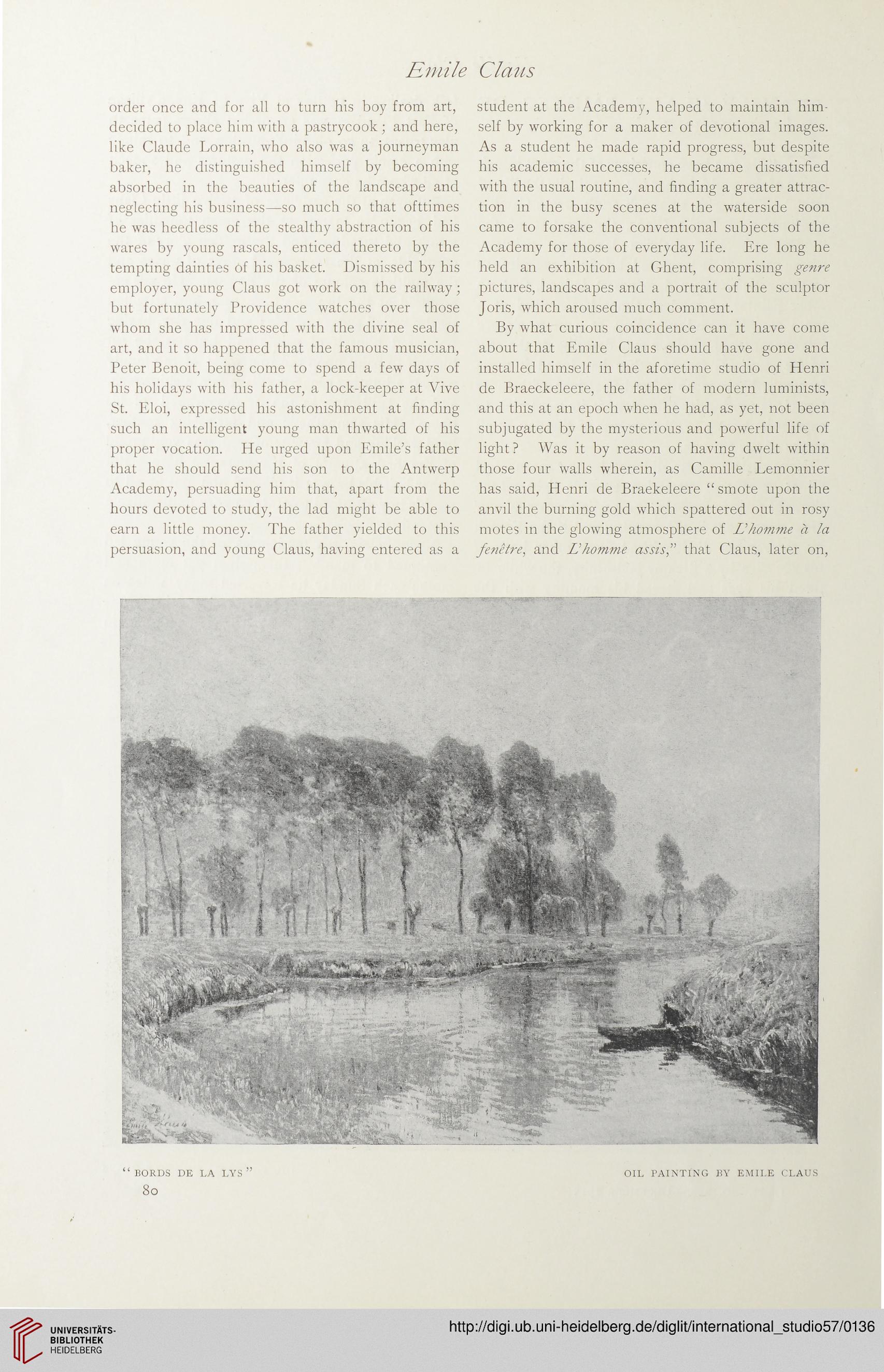Emile Clams
order once and for all to turn his boy from art,
decided to place him with a pastrycook; and here,
like Claude Lorrain, who also was a journeyman
baker, he distinguished himself by becoming
absorbed in the beauties of the landscape and
neglecting his business—so much so that ofttimes
he was heedless of the stealthy abstraction of his
wares by young rascals, enticed thereto by the
tempting dainties of his basket. Dismissed by his
employer, young Claus got work on the railway;
but fortunately Providence watches over those
whom she has impressed with the divine seal of
art, and it so happened that the famous musician,
Peter Benoit, being come to spend a few days of
his holidays with his father, a lock-keeper at Vive
St. Eloi, expressed his astonishment at finding
such an intelligent young man thwarted of his
proper vocation. He urged upon Emile’s father
that he should send his son to the Antwerp
Academy, persuading him that, apart from the
hours devoted to study, the lad might be able to
earn a little money. The father yielded to this
persuasion, and young Claus, having entered as a
student at the Academy, helped to maintain him-
self by working for a maker of devotional images.
As a student he made rapid progress, but despite
his academic successes, he became dissatisfied
with the usual routine, and finding a greater attrac-
tion in the busy scenes at the waterside soon
came to forsake the conventional subjects of the
Academy for those of everyday life. Ere long he
held an exhibition at Ghent, comprising genre
pictures, landscapes and a portrait of the sculptor
Joris, which aroused much comment.
By what curious coincidence can it have come
about that Emile Claus should have gone and
installed himself in the aforetime studio of Henri
de Braeckeleere, the father of modern luminists,
and this at an epoch when he had, as yet, not been
subjugated by the mysterious and powerful life of
light? Was it by reason of having dwelt within
those four walls wherein, as Camille Lemonnier
has said, Henri de Braekeleere “smote upon the
anvil the burning gold which spattered out in rosy
motes in the glowing atmosphere of Llhomme a la
fenetre, and L'homme as sis” that Claus, later on,
“ BORDS DE LA LYS”
8o
OIL PAINTING BY EMILE CLAUS
order once and for all to turn his boy from art,
decided to place him with a pastrycook; and here,
like Claude Lorrain, who also was a journeyman
baker, he distinguished himself by becoming
absorbed in the beauties of the landscape and
neglecting his business—so much so that ofttimes
he was heedless of the stealthy abstraction of his
wares by young rascals, enticed thereto by the
tempting dainties of his basket. Dismissed by his
employer, young Claus got work on the railway;
but fortunately Providence watches over those
whom she has impressed with the divine seal of
art, and it so happened that the famous musician,
Peter Benoit, being come to spend a few days of
his holidays with his father, a lock-keeper at Vive
St. Eloi, expressed his astonishment at finding
such an intelligent young man thwarted of his
proper vocation. He urged upon Emile’s father
that he should send his son to the Antwerp
Academy, persuading him that, apart from the
hours devoted to study, the lad might be able to
earn a little money. The father yielded to this
persuasion, and young Claus, having entered as a
student at the Academy, helped to maintain him-
self by working for a maker of devotional images.
As a student he made rapid progress, but despite
his academic successes, he became dissatisfied
with the usual routine, and finding a greater attrac-
tion in the busy scenes at the waterside soon
came to forsake the conventional subjects of the
Academy for those of everyday life. Ere long he
held an exhibition at Ghent, comprising genre
pictures, landscapes and a portrait of the sculptor
Joris, which aroused much comment.
By what curious coincidence can it have come
about that Emile Claus should have gone and
installed himself in the aforetime studio of Henri
de Braeckeleere, the father of modern luminists,
and this at an epoch when he had, as yet, not been
subjugated by the mysterious and powerful life of
light? Was it by reason of having dwelt within
those four walls wherein, as Camille Lemonnier
has said, Henri de Braekeleere “smote upon the
anvil the burning gold which spattered out in rosy
motes in the glowing atmosphere of Llhomme a la
fenetre, and L'homme as sis” that Claus, later on,
“ BORDS DE LA LYS”
8o
OIL PAINTING BY EMILE CLAUS




